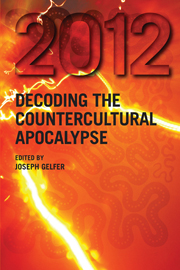Book contents
- Frontmatter
- Contents
- Contributors
- Preface
- 1 Introduction
- 2 The 2012 Phenomenon: New Uses for an Ancient Maya Calendar
- 3 Maya Prophecies, 2012 and the Problematic Nature of Truth
- 4 Mayanism Comes of (New) Age
- 5 The 2012 Milieu? Hybridity, Diversity and Stigmatised Knowledge
- 6 Chichén Itzá and Chicken Little: How Pseudosciences Embraced 2012
- 7 Roland Emmerich's 2012: A Simple Truth
- 8 The 2012 Movement, Visionary Arts and Psytrance Culture
- 9 In a Prophetic Voice: Australasia 2012
- 10 Approaching 2012: Modern Misconceptions versus Reconstructing Ancient Maya Perspectives
- Notes
- Index
Preface
- Frontmatter
- Contents
- Contributors
- Preface
- 1 Introduction
- 2 The 2012 Phenomenon: New Uses for an Ancient Maya Calendar
- 3 Maya Prophecies, 2012 and the Problematic Nature of Truth
- 4 Mayanism Comes of (New) Age
- 5 The 2012 Milieu? Hybridity, Diversity and Stigmatised Knowledge
- 6 Chichén Itzá and Chicken Little: How Pseudosciences Embraced 2012
- 7 Roland Emmerich's 2012: A Simple Truth
- 8 The 2012 Movement, Visionary Arts and Psytrance Culture
- 9 In a Prophetic Voice: Australasia 2012
- 10 Approaching 2012: Modern Misconceptions versus Reconstructing Ancient Maya Perspectives
- Notes
- Index
Summary
With all the hoopla and ballyhoo surrounding the supposed end of the world in 2012, it would be somewhat pleasant for my ego if I had started the whole uproar in a book published over four decades ago, as some Internet sites claim. But this is not what actually happened. The book was the first edition of The Maya, which came out in 1966 (London: Thames & Hudson), and in it I had this to say:
The idea of cyclical creations and destructions is a typical feature of Mesoamerican religions, as it is of Oriental. The Aztec, for instance, thought that the universe had passed through four such ages, and that we were now in the fifth, to be destroyed by earthquakes. The Maya thought along the same lines, in terms of eras of great length, like the Hindu kalpas. There is a suggestion that each of these measured 13 baktuns, or something less than 5,200 years, and that Armageddon would overtake the degenerate peoples of the world and all creation on the final day of the thirteenth. Thus, following the Thompson correlation, our present universe would have been created in 3113 BC, to be annihilated on December 24, AD 2011, when the Great Cycle of the Long Count reaches completion (p. 149).
All well and good—I probably was out to scare my readers a bit, but the date was so far in the future that I thought that most of them would be dead anyway by that time.
- Type
- Chapter
- Information
- 2012Decoding the Countercultural Apocalypse, pp. viii - xiiPublisher: Acumen PublishingPrint publication year: 2012



